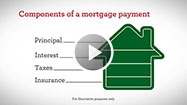How to Know What House You Can Afford
If you obtain home financing, you'll repay more than the amount you borrowed because the amount you repay is determined by several factors, including the interest and loan amount. Here are some terms you should understand.
Interest rate
- The interest rate is the percentage of your loan amount we charge you to borrow money.
- Interest rates are based on current market conditions, your credit score, down payment, and the type of mortgage you choose. Check today's rates.
Discount Points
- One point equals 1% of your mortgage amount; however, 1 point will typically reduce the interest rate by less than 1%. If you qualify, you may be able to pay one or more points to lower your interest rate. A lower interest rate means lower monthly mortgage payments.
- Points are usually tax deductible. Consult a tax advisor regarding tax deductibility. On refinances you may be able to finance points as part of your mortgage amount.
Origination charge
- On a mortgage, this amount includes charges (other than discount points) that all loan originators (lenders and brokers) involved will receive for originating the loan.
- The origination charge covers items including fees, document preparation, and underwriting costs, and other expenses.
- On refinances, if you qualify, you may be able to finance the origination charge as part of your loan amount.
Loan term
- Your loan term is the amount of time you have to pay off your mortgage balance.
- Shorter loan terms typically mean higher monthly mortgage payments, but often have lower interest rates.
- If you pay off your mortgage balance within a shorter term, you may pay less in total interest than with a longer-term mortgage.
Remember that interest rates only tell part of the story. The cost of a mortgage is reflected by the interest rate, discount points, fees, and origination charges. This cost is known as the annual percentage rate (APR), which is typically higher than the interest rate. The APR lets you compare mortgages of the same dollar amount by considering their annual cost.
Monthly mortgage payment
Your monthly mortgage payment is typically made up of four parts:
- Principal. The part of your monthly payment that reduces the outstanding balance of your mortgage.
- Interest. The part of your monthly payment that goes toward the cost of borrowing the money.
- Taxes. The part of your monthly payment that goes toward property taxes charged by your local government. We typically collect a portion of these taxes in every mortgage payment and hold the funds in an escrow account for tax payments made on your behalf as they become due.
- Insurance. The part of your monthly payment that pays for homeowners or hazard insurance, which provides protection against losses from property damage due to wind, fire, or other risks. Like taxes, insurance costs are usually collected and paid from an escrow account.
Depending upon your property location, property type, and loan amount, you may have other monthly or annual expenses such as mortgage insurance, flood insurance, or homeowner association fees.
Video – The components of a mortgage payment
 Watch this video to understand what makes up a typical mortgage payment – principal, interest, taxes, and insurance – and how they can change over the life of the loan.
Watch this video to understand what makes up a typical mortgage payment – principal, interest, taxes, and insurance – and how they can change over the life of the loan.
Check today's rates to see our current interest rates.
How to Know What House You Can Afford
Source: https://www.wellsfargo.com/mortgage/home-affordability-calculator/
0 Response to "How to Know What House You Can Afford"
Post a Comment